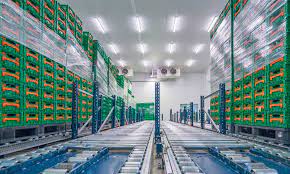In the realm of industrial operations, warehouses play a pivotal role in storing and managing goods, ensuring a seamless supply chain, and meeting the demands of a globalized market. However, the effective functioning of these warehouses hinges not only on impeccable logistics but also on ensuring the safety of personnel and the preservation of stored goods. One crucial element that contributes to achieving these goals is warehouse netting – a versatile solution that enhances safety, optimizes space, and safeguards inventory. This article delves into the significance of warehouse netting, its types, applications, benefits, and considerations for implementation.
Understanding Warehouse Netting
Warehouse netting, also known as safety netting or industrial netting, is a protective barrier made of durable materials like nylon, polyethylene, or metal that is installed within warehouses to prevent accidents, secure products, and create more efficient storage solutions. It’s designed to act as a barrier between stored items, personnel, and equipment, effectively containing and protecting inventory while promoting a safer working environment.
Types of Warehouse Netting
Rack Safety Netting: This type of netting is attached to the back of pallet racks or shelving units to prevent items from falling off and causing potential injuries. It helps keep items in place, even during seismic activities or when shelves are bumped accidentally.
Mezzanine Safety Netting: Mezzanine floors are often used to maximize vertical space within warehouses. Mezzanine safety netting prevents items from falling from these elevated storage areas, enhancing safety for workers on lower levels.
Pallet Rack Netting: This netting is designed to secure individual pallets on racks, ensuring they remain in place during storage and retrieval processes.
Debris Netting: Debris netting is commonly used in construction and renovation projects within warehouses. It prevents dust, debris, and construction materials from spreading to other areas, maintaining a clean and safe working environment.
Personnel Safety Netting: In areas where workers operate at heights, such as loading docks or elevated work platforms, personnel safety netting acts as a fall arrest system, preventing serious accidents.
Wire Mesh Partitions: While not traditional netting, wire mesh partitions create designated areas within the warehouse, enhancing security, organization, and safety.
Applications of Warehouse Netting
Fall Prevention: Warehouse netting is a critical component for preventing falls from elevated storage areas, platforms, and loading docks. By acting as a safety barrier, it reduces the risk of injuries that can occur due to accidental slips or trips.
Inventory Protection: By preventing items from falling off shelves or racks, warehouse netting safeguards inventory from damage, ensuring product quality and reducing potential losses.
Space Optimization: Implementing netting solutions allows for more efficient utilization of vertical space. Mezzanines and high racks can be used effectively without compromising safety or organization.
Worker Safety: Warehouse netting contributes to worker safety by reducing the risk of falling objects. Employees can work confidently, knowing that they are protected from potential hazards.
Debris Containment: During construction or maintenance activities, debris netting keeps dust, debris, and materials contained, maintaining a cleaner working environment and preventing contamination of stored goods.
Benefits of Warehouse Netting
Enhanced Safety: The primary benefit of warehouse netting is undoubtedly the improved safety it provides. It minimizes the risk of accidents, injuries, and damage to both personnel and inventory.
Cost Savings: By preventing accidents and inventory damage, warehouse netting contributes to cost savings in terms of medical expenses, potential legal liabilities, and lost productivity.
Regulatory Compliance: Many industries have stringent safety regulations and standards. Implementing warehouse netting ensures compliance with these regulations, avoiding fines and penalties.
Product Integrity: Warehouse netting safeguards inventory from falling and colliding with other items, ensuring that goods maintain their quality and market value.
Optimized Storage: The use of netting allows for creative storage solutions, such as utilizing mezzanine floors and high racks. This optimization of space can lead to increased storage capacity and better organization.
Considerations for Implementing Warehouse Netting
Risk Assessment: Conduct a thorough risk assessment to identify areas where netting is most needed. Focus on high-risk zones, such as elevated platforms and areas with heavy foot traffic.
Quality and Durability: Choose netting materials that are durable and suitable for the specific application. Quality materials ensure that the netting will withstand the rigors of industrial environments.
Professional Installation: Proper installation is crucial for the effectiveness of warehouse netting. Hiring professionals ensures that the netting is securely installed and aligned with safety standards.
Regular Inspection and Maintenance: Regularly inspect netting for signs of wear, damage, or degradation. Address any issues promptly to maintain a safe working environment.
Employee Training: Train warehouse personnel about the purpose and proper use of netting. This ensures that everyone understands its role in safety and operates within established guidelines.
Adaptability: As warehouse operations evolve, the need for netting solutions may change. Choose netting that can be adapted or expanded to accommodate evolving needs.
Conclusion
Warehouse netting serves as a critical element in modern industrial operations, ensuring safety, protecting inventory, and optimizing storage space. By preventing accidents, promoting efficient organization, and complying with safety regulations, warehouse netting enhances overall warehouse functionality. From preventing falls to preserving product quality, its benefits are far-reaching, making it an indispensable tool for any warehouse looking to create a safer and more efficient working environment.














